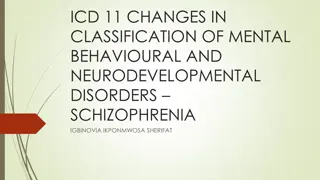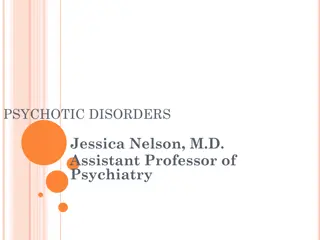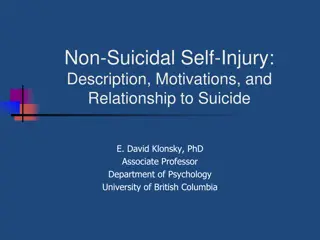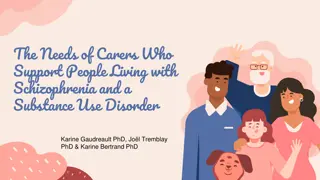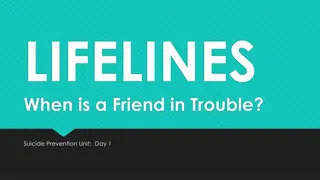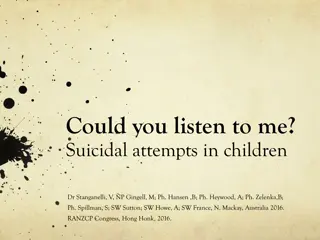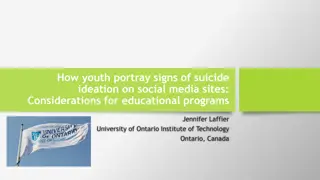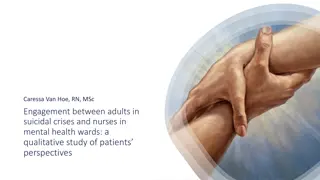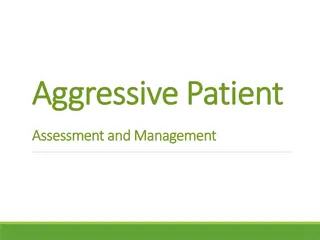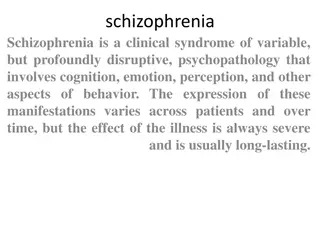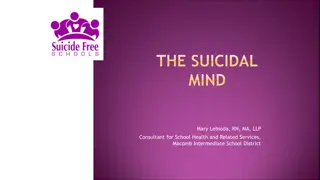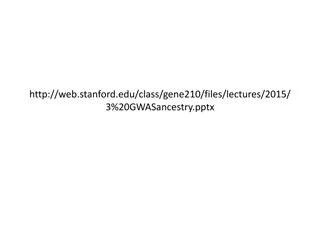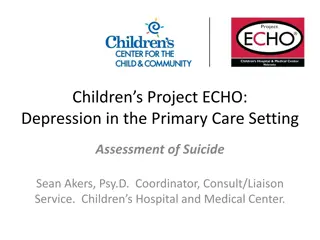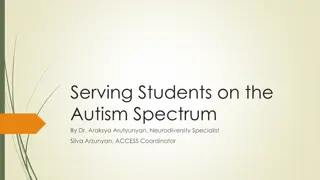Impulsivity and Suicidal Ideation in Schizophrenia Spectrum Disorder
This study by Matthew J. Hoptman, PhD, explores the relationship between emotion-based impulsivity, emotion regulation, and suicidal ideation and behavior in schizophrenia spectrum disorder. It examines the dimensions of impulsivity, including urgency, in individuals with schizophrenia compared to healthy controls. The research highlights the importance of understanding impulsivity in this population for identifying treatment implications related to suicidal behavior.
Download Presentation

Please find below an Image/Link to download the presentation.
The content on the website is provided AS IS for your information and personal use only. It may not be sold, licensed, or shared on other websites without obtaining consent from the author.If you encounter any issues during the download, it is possible that the publisher has removed the file from their server.
You are allowed to download the files provided on this website for personal or commercial use, subject to the condition that they are used lawfully. All files are the property of their respective owners.
The content on the website is provided AS IS for your information and personal use only. It may not be sold, licensed, or shared on other websites without obtaining consent from the author.
E N D
Presentation Transcript
Emotion-based impulsivity, emotion regulation, and suicidal ideation and behavior in schizophrenia spectrum disorder By: Matthew J. Hoptman, PhD
Disclosures This project was supported by Grant SRG-0-064-17 awarded to Matthew Hoptman from the American Foundation for Suicide Prevention. The content is solely the responsibility of the authors and does not necessarily represent the official views of the American Foundation for Suicide Prevention.
OUTLINE Outline Impulsivity Findings on emotion-related impulsivity in schizophrenia (urgency) Suicidality in schizophrenia Treatment implications Broader implications
IMPULSIVITY IN SCHIZOPHRENIA Dimensions of Impulsivity Disagreement about what constitutes impulsivity Delayed discounting, response inhibition, lack of planning, sensation seeking Decoupling of emotion from impulsivity (BIS; Barratt, 1993) Subscales: motor, attentional, and nonplanning impulsivity Development of newer scales to measure impulsivity (Whiteside and Lynam, 2001) Subscales of urgency, lack of premeditation, lack of planning, and sensation seeking (UPPS) Urgency: rash action in the context of strong emotions Example: When I feel bad, I will often do things I later regret in order to make myself feel better now. Addition of positive urgency (Cyders and Smith, 2007) UPPS-P
IMPULSIVITY IN SCHIZOPHRENIA Newer Findings on Impulsivity Urgency is elevated in numerous psychiatric disorders - Specificity in bulimia - ADHD + ODD - Alcohol and substance use disorders Schizophrenia is characterized by reduced affective expression, but experience of emotion is equivalent to healthy individuals (Green & Lee, 2012)
IMPULSIVITY IN SCHIZOPHRENIA Urgency in Schizophrenia Study of impulsivity and aggression in schizophrenia (Hoptman et al., 2014) 33 patients with schizophrenia or schizoaffective disorder 31 healthy controls Patients were administered the UPPS-P, the Aggression Questionnaire, the Impulsive/ Premeditated Aggression Scale, and the Life History of Aggression MRI scanning: resting-state fMRI and cortical thickness
IMPULSIVITY IN SCHIZOPHRENIA Urgency was selectively increased in schizophrenia Hoptman et al. 2014
IMPULSIVITY IN SCHIZOPHRENIA Reduced cortical thickness in ventral prefrontal regions was associated with urgency, as was their functional connectivity with limbic and other frontal regions Hoptman et al., 2014
URGENCY AND SUICIDALITY Suicidality in Schizophrenia Suicidal ideation and behavior (SIB) is highly elevated in schizophrenia, with up to 40% having at least one attempt and 5-10% of patients dying by suicide Rate of death from suicide is higher than in major depressive disorder The mechanisms underlying SIB in schizophrenia are poorly understood, but we have hypothesized that it may relate to poor emotion regulation, which may in turn be related to urgency Psychotic symptoms may also associate with SIB, particularly those related to command auditory hallucinations and paranoid delusions
URGENCY IN SUICIDALITY AFSP funded study Enrolled 35 people with schizophrenia spectrum disorder Inclusion: ages 18-60 years Exclusion: recent alcohol or substance use disorder, significant, unstable medical illness, score of 2 on the Columbia-Suicide Severity Rating Scale (C-SSRS; Posner et al., 2011) for both lifetime and the past year Eligibility determined by CSSR-S High SIB group (n=18) 2+ attempts AND/OR Score of 3-5 on C-SSRS in the past 12 months Low SIB group (n=17) No attempts Score of <2 on C-SSRS lifetime Hoptman et al., 2023
URGENCY IN SUICIDALITY Assessments UPPS-P Urgency, (Lack of) Premeditation, (Lack of Perseverance), Sensation Seeking scale (Whiteside & Lynam, 2001; Cyders & Smith, 2007) Beck Scale for Suicidal Ideation (BSSI; Beck and Steer, 1991) Provides ratings for suicidal ideation (past week) Positive and Negative Syndrome Scale (PANSS; Kay et al., 1987) Rates psychopathology (Positive, Negative, Excited Mood, Cognition, and Depression symptoms) for past-week Hoptman et al., 2023
URGENCY IN SUICIDALITY Behavioral Results Positive and Negative Urgency correlated positively with BSSI total scores (rS> .38, ps < .025). Negative urgency also correlated with lifetime suicide attempts (rs= .48, p = .003). Negative urgency correlated positively with Excitement and Depression Scale (rS> .41, ps = .015) Excitement and Depression symptoms correlated positively with BSSI Scores (rS> .61, p < .001). Likewise, lifetime suicide attempts correlated with PANSS Excitement (rs= and Depression (rs> .36, p = .031) factors. Hoptman et al., 2023
URGENCY IN SUICIDALITY Prediction of Group Membership To examine which of the interrelated measures were most important in predicting group membership, we conducted a binary logistic regression analysis Negative urgency was the significant variable, discriminating groups (OR = 1.12, p = .045) Group membership was predicted with 77% accuracy Hoptman et al., 2023
URGENCY IN SUICIDALITY Quantile multiple regression and mediation analyses showed that only Negative Urgency mediated the relationship between the BSSI total scores and the PANSS Excitement and Depressions factor. This mediation effect for Depression accounted for 46% of the total effect in BSSI scores The reverse was not true for Depression, but was for Excitement Hoptman et al., 2023
IMAGING AND SUICIDALITY IN SSD Neuroimaging Participants completed a task where they saw emotionally negative or neutral pictures from a standardized set (Foti & Hajcak, 2008; Wang et al., 2017) Half of the emotionally negative pictures were preceded by a neutral spoken sentence (NeutNeg), and half were preceded by a negative sentence (NegNeg). All neutral pictures were preceded by a neutral sentence After each picture, participants rated the unpleasantness of the picture The neutral statement for negative pictures is meant to render the negative picture as less unpleasant than when the negative sentence is presented Unpublished results, do not cite
IMAGING AND SUICIDALITY IN SSD Task Schematic Unpublished results, do not cite
IMAGING IN SUICIDALITY IN SSD Neuroimaging Results Participants reliably related NegNeg pictures as more unpleasant than NeutNeg pictures (p = 10-5) An fMRI comparison (NeutNeg-NeutNeut) on the emotion regulation task was associated with higher activation in left and right superior frontal gyrus, right middle cingulate gyrus, right dorsolateral prefrontal cortex (DLPFC), left medial frontal gyrus, and right superior temporal gyrus in the low SIB than the high SIB group (TFCE threshold p = .05, corrected). Across groups, activation in most of these regions correlated negatively with SIB on multiple measures on the C-SSRS. Activation in several of these regions correlated negatively with negative urgency (rs< - .41, ps < .023). Unpublished results, do not cite
IMAGING IN SUICIDALITY IN SSD Medial Lateral LH RH Unpublished results, do not cite
CONCLUSIONS Conclusions Results also support the idea that negative urgency rash action in the context of strong negative emotions is an important predictor of SIB in schizophrenia. Project supports the hypothesis that there is a deficit in activation of emotion regulation circuitry in people with schizophrenia who have high levels of SIB compared to those with low levels of SIB that is related to negative urgency. Critical questions for the future have to do with the dynamics of emotion regulation and/or urgency and what the situation is in those in early psychosis Unpublished results, do not cite


